All Walks DC calls for removal of unsignalized crosswalks
======
I republished this entry because I added some photos and text at the end.
======
All Walks DC is a pedestrian advocacy group in the city. According to the Northwest Current, the group is suggesting that unsignalized crosswalks ought to be eliminated since they encourage pedestrians to be overconfident crossing the street. From "Residents call for solutions after crashes" (6/24/2015, page 1):
All Walks DC, a group that advocates for pedestrian rights, wants all crosswalks in the city without traffic signals to be studied and considered for removal. D.C. Department of Transportation officials say these crosswalks can give pedestrians a false sense of security, because even though drivers are required to yield to a pedestrian in a crosswalk they often don’t do so.This recommendation was made after two fatal accidents on Wisconsin Avenue NW a couple weeks ago.
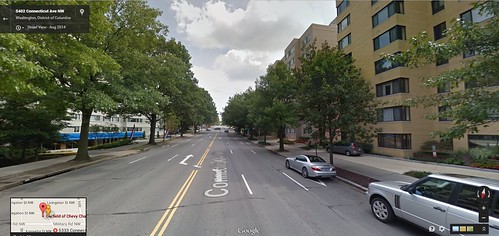
Connecticut Avenue NW. Google image.
While I understand the desire, I think it's a misguided recommendation.
People are going to cross the street with or without a marked crosswalk, especially at intersections.
Lack of markings will only encourage motor vehicle operators to ignore pedestrians more.
It's better to direct pedestrian crossings to defined locations, where additional treatments can be provided. AND to provide improvements to pedestrian crossings.
Rather than making an off the cuff recommendation, like removing the markings, it's best to start with PEDSAFE, the Pedestrian Safety Guide and Countermeasure Selection System, an FHWA publication that is used to analyze pedestrian accidents with the aim of making physical improvements, focused on improving safety, when the analysis indicates that road and traffic engineering elements contributed to the accident.
Arterials in Upper Northwest DC are problematic because the roads tend to be wide and if not framed by taller buildings (for DC), the buildings are set back a fair distance from the road and the areas aren't replete with pedestrians.
This creates a kind of tunnel or alley effect, encouraging fast driving.
The problem is accentuated because outside of the core of the city, where there are fewer pedestrians generally, most drivers fail to realize that when one car stops in a lane on the street near a crosswalk, it's not because the driver is acting stupid, but because there is a pedestrian crossing the street.
Drivers in all the lanes should stop when a car stops in one of the lanes, but we haven't built into our mental frameworks this kind of driving behavior as an automatic response when we are in that situation.
It's not possible, probably, to put in a median, or to narrow the lanes in a manner which would lower speeds and improve safety, other than maybe adding a cycletrack. But cycletracks are problematic too because the arterials may provide the majority of parking for commercial areas, making the removal of parking difficult.
Besides adding signals, either regular Traffic Signals or special Pedestrian Crossing Signals, which isn't likely to happen at every block without a regular traffic signal because of the short distance between blocks, the basic recommendations I'd make, which are in the guide, would include Crosswalk Enhancements, Raised Pedestrian Crossings, and Advance Yield/Stop Lines.
Other recommendations I'd make aren't necessarily in the guide, but should be in the Manual of Uniform Traffic Control Devices, and include:
rumble strips a certain distance from unsignalized crosswalks (also mentioned in Best Practices for Arterial Speed Management, prepared for the City of Pasadena).
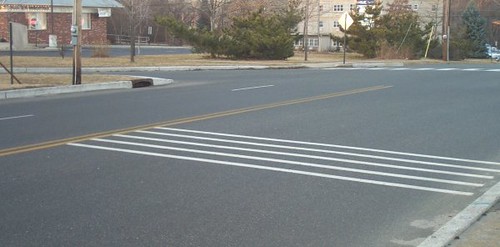
special crosswalk treatments for all or most unsignalized intersections, either real brick
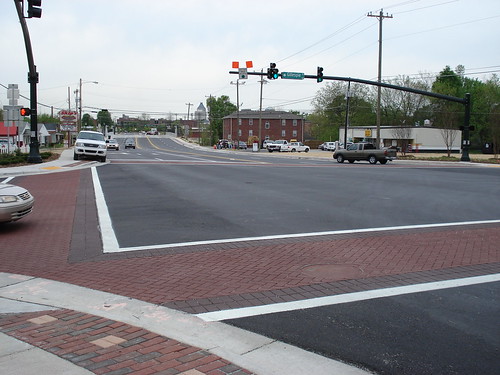
Brick crosswalk. Image from My Asphalt Dr.
or faux brick. (Faux treatments, "thermoplastic" markings, do need to be reapplied more frequently because of wear--friction from tires.)
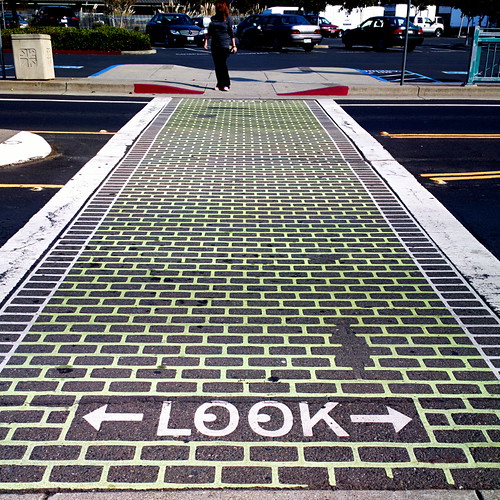
Flickr photo by Jym Dyer.
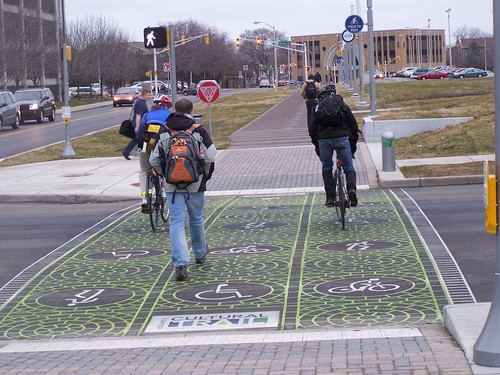
Indianapolis Cultural Trail
special markings for unsignalized intersections, although this treatment is at signalized intersections on Georgia Avenue at Kansas and New Hampshire Avenues NW, and includes brick crosswalks too.
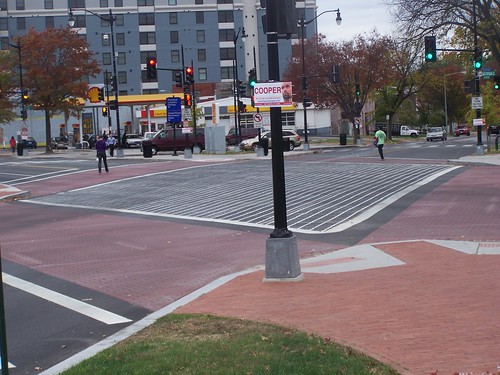
changing the road material to asphalt blocks to provide visual, physical, and aural cues to drive more slowly (also mentioned in Best Practices for Arterial Speed Management), which I think that the city should be doing anyway, on arterial sections proximate commercial districts, schools, parks, and other public facilities.
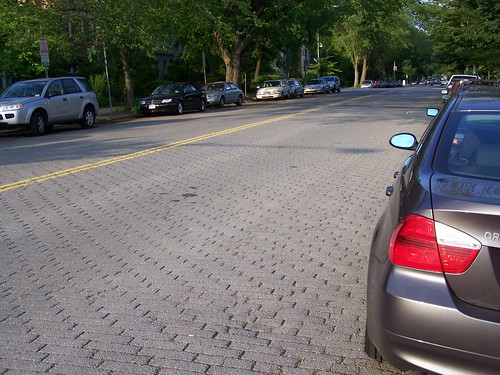
While there are some remnant examples of asphalt brick on collector streets in Capitol Hill and (cobble) stone block street pavements on local residential streets in Georgetown, and in front of Eastern Market, there are no modern examples of installation of these kinds of pavement materials on a major arterial.
O and P Streets NW in Georgetown still have stone block pavement, because the streetcar tracks have been retained as a historical element.
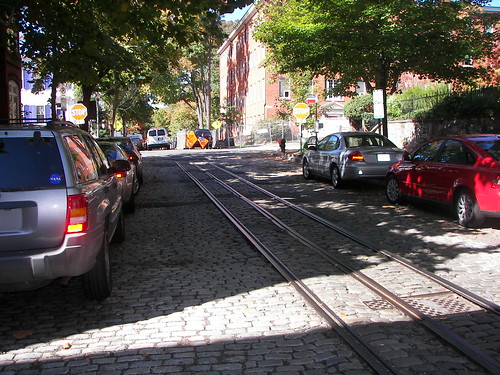
Special pavers were installed on 7th Street SE as part of the rehabilitation program for the Eastern Market public market building. Currently, this pavement is on the 200 block of 7th Street SE and will be installed when the 300 block is reconstructed in association with the redevelopment of the Hine School site. I have argued that this treatment should be extended across Pennsylvania Avenue and around the Eastern Market Metro Plaza.

When Pennsylvania Avenue was closed in front of the White House for security reasons, the road was repaved with a special treatment also. Image from the American Society of Landscape Architects.

In London, Exhibition Road, which serves as a "museum mile" for the city, has a similar treatment, finished in 2012, and while a shared space, the road is not closed to through traffic. Images from Davis Landscape Architecture.
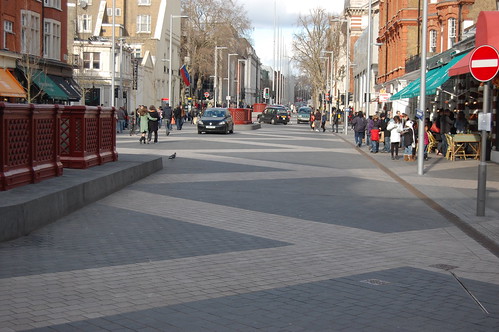
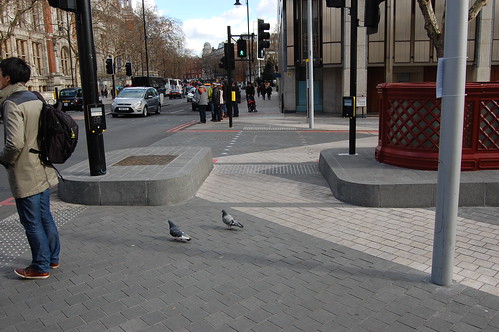
Labels: bicycle and pedestrian planning, car culture and automobility, pedestrian safety, traffic engineering, traffic safety and enforcement, urban design/placemaking




10 Comments:
A pedestrian advocacy organization is calling for the removal of crosswalks at non-signalized intersections?!? That is crazy. Calling the idea "off the cuff" is perhaps too kind. In my neighborhood, crossing streets only at signalized intersections would mean walking many blocks out of my way for some of my most basic and common trips (Metro, grocery store, hardware store, etc.) Indeed, when I go the hardware store, I walk nearly five blocks and none of the intersections has a signal. A pedestrian advocacy organization should not be advocating for "solutions" that reduce mobility and make life more difficult for pedestrians. God forbid we would ask drivers to accept any inconvenience. It is a sad sign of how our society elevates drivers over the rest of us when a pedestrian advocacy organization pushes "solutions" that would minimize inconvenience for drivers and maximize it for pedestrians. (Apparently, a few deaths and injuries a year is acceptable if it means saving a non-taxpaying Maryland commuter 45 seconds.) They should be advocating for better and safer design and for greater pedestrian convenience. The stretch of Wisconsin where drivers killed pedestrians was given a safer design but then changed back after our weak city officials caved to entitled drivers. I hope those who advocated for return to the less safe design are happy. Someone died? Meh -- I still save 30 seconds every time I drive down Wisconsin.
Non-sequitor other than it addresses roads: Posted this farther down yesterday...
http://solarenergy.net/News/solar-innovation-roads-made-solar-panels-become-reality/
-EE
missed that. thanks for the repost.
rg -- I wanted to write what you said but I am trying to "be helpful" rather than outraged.
That's a crazy suggestion, and a pedestrian advocacy group ought to familiarize itself with best practice and key resources in the field before making crazy ass suggestions like eliminating unsignalized crosswalks, because people will still cross the street ESPECIALLY AT EXISTING INTERSECTIONS, which are block by block anyway.
I didn't realize that pedestrian-focused improvements on the corridor were scotched previously.
Frankly they need to redo all the crosswalks along the lines I said, do rumble strips too, and set up enforcement and/or cameras to ticket the f* out of people who aren't stopping.
Helpful is better than outraged. If I really wanted to make a difference, I would become an active member, etc. and put my money, or at least my time, where my mouth is. But still, what were they thinking! :-)
Jacob Mason, Vice President of All Walks DC here. I just wanted to jump in here and set the record straight. All Walks DC advocates for safe and convenient walking throughout DC, including safe crossings at ALL intersections. In other words, if an intersection is unsafe to cross we want to make it safe. We're happy to see your thoughtful suggestions for how to make that happen, and we will certainly reference your ideas going forward.
We've written to the Northwest Current to clarify our position with them as well, and our blog post below goes into a bit more detail:
http://allwalksdc.org/2015/07/clarifying-all-walks-dcs-position-on-unmarked-crosswalks/
Please let me know if you have any questions.
Sincerely,
Jacob Mason
Vice President
All Walks DC
mason (dot) jacob (at) gmail (dot) com
The best way to make an unsafe crossing safe is usually better signage before and at the crosswalk. Also, adding "sharks teeth" yield lines before unsignalized crosswalks lets drivers know that they are supposed to yield to pedestrians there.
If you can do other things to slow down traffic, it is more likely that people will yield as well. Raised crosswalks, raised intersections, etc. tend to work well, as well as other traffic calming such as chicanes or curb extensions.
I've found that when there are unmarked crosswalks on major streets, drivers think that pedestrians are not allowed to cross there at all and are more likely to honk or harass pedestrians.
Thanks for these recommendations.
It's worth checking to see if all crosswalks on major arterials like CT and WI Avenues have signage.
I think that road markings would help.
I don't bulbouts are in store for the major avenues in the city, although they are used on secondary arterials, like 12th St. in Brookland.
Chicanes are used a bit in DC, but they aren't really a strategy for primary arterials. Takoma Park uses them, again, not on major arterials (which there are controlled by the state).
I hate to admit I don't have a lot of experience using the MUTCD book, where shark teeth are probably discussed in great detail. We don't have many examples here.
I do think that they should be considered for a standard treatment on major arterials for unsignalized crosswalks.
That's what I was thinking when I mentioned rumble strips.
It'd be interesting to do a test of both.
I did come across some rumble strips the other day on 15th St. NE, but I haven't uploaded photos yet.
Halloween is the spookiest time of year. On October 31, ghouls, goblins, and monsters of all sorts take to the streets for a few tricks and plenty of treats. Families will be out with their children who hope to score big and take home pounds of candy. However, spookier than the vampire making his way down your street is the increase in pedestrian accidents on All Hallows Eve. Even scarier is the fact that Halloween falls on a Saturday this year providing people with the opportunity to have a little too much fun.
An increase in pedestrians alone can mean an increase in the chances of drivers injuring those taking to the streets on foot. Because trick-or-treating typically begins as the sun sets, visibility of a driver and a pedestrian can become poor. Masks create an issue by blocking the vision of those wearing them. Additionally, young adults and teens tend to use Halloween as an opportunity to revel in the excitement that surrounds the holiday and overindulge in alcoholic beverages thereby impairing their abilities to drive. And while it’s fun to judge all the creative and scary costumes that people come up with each year, this can lead to a case of distracted driving. These factors significantly increase the risk of causing serious injury or death to a pedestrian.
Post a Comment
<< Home